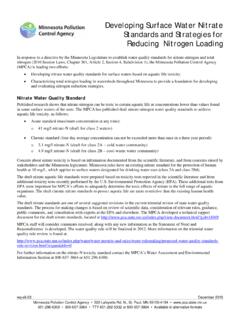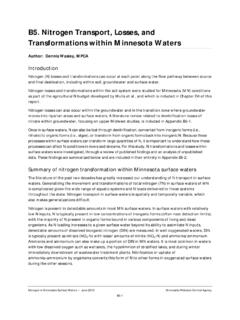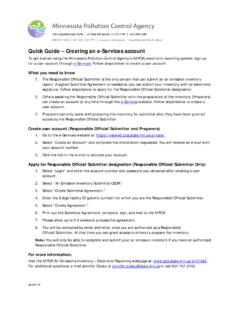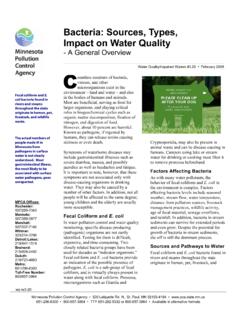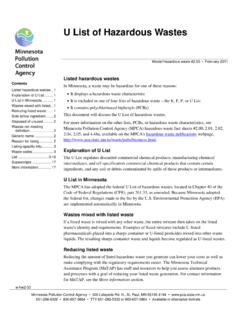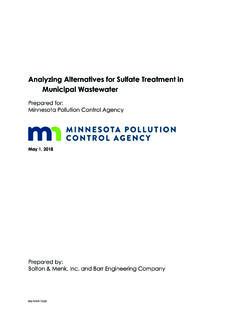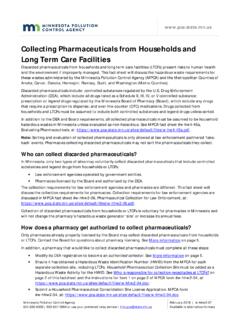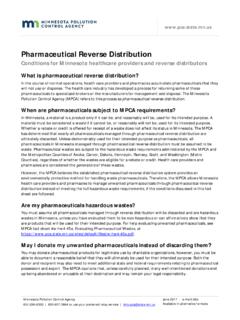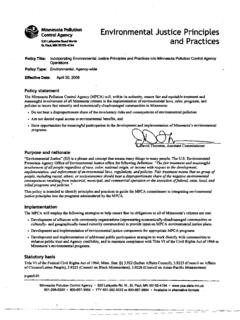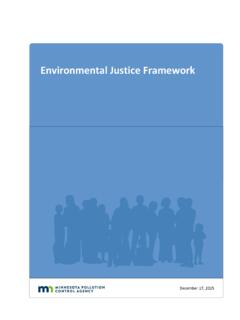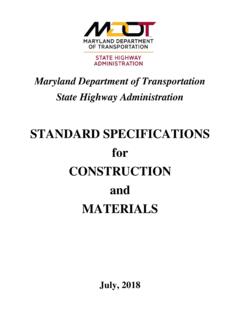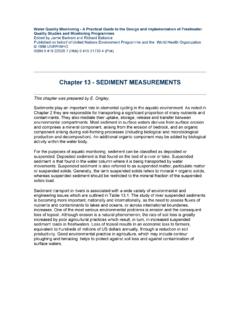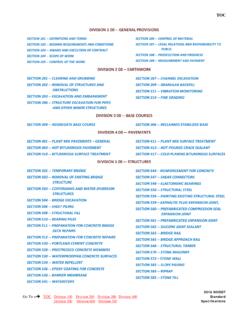Transcription of Turbidity: Description, Impact on Water Quality, Sources ...
1 turbidity : Description, Impact on Water quality , Sources , Measures - A General Overview Water quality /Impaired Waters # March 2008 Minnesota Pollution Control Agency 520 Lafayette Rd. N., St. Paul, MN 55155-4194 651-296-6300 800-657-3864 TTY 651-282-5332 or 800-657-3864 Available in alternative formats Soil erosion on crop land has been a focus of soil and Water conservation programs for many years. Urban stormwater runoff is also recognized as an important contributor of sediment , whether from construction sites, runoff from impervious surfaces, or other Sources . wq-iw3-21 MPCA Area Offices: Rochester area: 507/285-7343 Mankato area: 507/389-5977 Marshall area: 507/537-7146 Willmar area: 320/214-3786 Detroit Lakes area: 218/847-1519 Brainerd area: 218/828-2492 Duluth area: 218/723-4660 Metro area: 651/296-6300 Toll-Free Number: 800/657-3864 any Total Maximum Daily Load projects in Minnesota address turbidity .
2 turbidity in Water is a measurement of how cloudy or murky it is. In your espresso or latte you want high turbidity . In your lake or stream, probably not. In either case, the substances resulting in high turbidity may not be intrinsically harmful, but their effects can be. Too much caffeine in the evening can affect sleep. Too much algae or sediment in lakes and streams can make them unsuitable for recreation and aquatic life. What Is turbidity ? turbidity is caused by particles suspended or dissolved in Water that scatter light making the Water appear cloudy or murky. Particulate matter can include sediment -especially clay and silt, fine organic and inorganic matter, soluble colored organic compounds, algae, and other microscopic organisms.
3 In the Minnesota River, sediment is the primary contributor to turbidity . In a shallow lake in August, it may be algae. In a northern Minnesota lake it may be tannin released by the breakdown of organic material. Impact of turbidity High turbidity can significantly reduce the aesthetic quality of lakes and streams, having a harmful Impact on recreation and tourism. It can increase the cost of Water treatment for drinking and food processing. It can harm fish and other aquatic life by reducing food supplies, degrading spawning beds, and affecting gill function. A report of the European Inland Fisheries Advisory Commission lists five ways that fine particles can have a harmful Impact on freshwater fish: acting directly on fish, killing them or reducing their growth rate, resistance to disease, etc.
4 ; preventing successful development of fish eggs and larvae; modifying natural movements and migrations; reducing the amount of food available; and affecting the efficiency of methods for catching fish. turbidity Sources sediment often tops the list of substances or pollutants causing turbidity . However, any watershed has multiple Sources of the pollutants or physical features that can affect Water clarity. These can be divided into natural or background, and human-induced Sources . Natural Sources can include erosion from upland, riparian, stream bank, and stream channel areas;M turbidity A General Overview Water quality /Impaired Waters # March 2008 page 2 however, this is difficult to measure due to agriculture and development activity.
5 Human activities can accelerate erosion . Tannic acids often associated with peat and bog areas cause Water to be colored resulting in turbidity . Algae that grow with nourishment from nutrients entering the stream through leaf decomposition or other naturally occurring decomposition processes can also be a source of turbidity . Stream channel movement can also release sediment . turbidity is affected by several factors in Water : presence of dissolved and suspended solids, size and shape of particles and composition of the particles. Water quality measurements that can help in the characterization of turbidity include total suspended solids, volatile suspended solids, total dissolved solids, suspended sediment concentration, chlorophyll a, and particle size analysis.
6 Other factors such as flow, sediment source and composition, algal species and sediment transport characteristics can also provide important information in characterizing the turbidity present in Water . Phosphorus from various Sources can cause algae growth resulting in increased turbidities. Phosphorus Sources may include wastewater treatment facilities, nutrient runoff from crop land and other Sources ; and bottom sediment . Organic matter from sewage discharges, especially during treatment plant bypasses, can contribute to turbidity . Soil erosion on crop land has been a focus of soil and Water conservation programs for many years.
7 Urban stormwater runoff is also recognized as an important contributor of sediment , from construction sites, impervious surfaces, or other Sources . Measuring turbidity turbidity Water quality Standard turbidity is measured using specialized optical equipment in a laboratory or in the field. A light is directed through a Water sample, and the amount of light scattered is measured. The unit of measurement is called a Nephelometric turbidity Unit (NTU), which comes in several variations. The greater the scattering of light, the higher the turbidity . Low turbidity values indicate high Water clarity; high values indicate low Water clarity.
8 Minnesota s Water quality standards include a turbidity number as a measure of whether a Water body meets its designated uses: Classes (and descriptions ) turbidity (NTU) 1B (drinking Water ) 10 2A (cold Water fishery, all recreation) 10 2B (cool/warm Water fishery, all recreation) 25 2C (indigenous fish, most recreation) 25 Measuring Water transparency and Total Suspended Solids (TSS) also can be used to predict turbidity values. Secchi disks in lakes and transparency tubes in streams provide a simple and low-cost method for measuring Water clarity. These are widely-used in citizen lake and stream monitoring programs.
9 Laboratory analysis is necessary for measuring TSS in milligrams per liter. Transparency Tube The relationship of TSS and transparency to turbidity across many streams indicates that 25 NTU is approximately equal to 58 mg/L for TSS and 20 centimeters of visibility through a T-tube. However, the relationship between turbidity and TSS can vary greatly in individual streams or even locations within a stream. More Information Protocol for turbidity TMDL Development: Minnesota River Basin Data Center: Water on the Web: Minnesota River turbidity TMDL Project.
